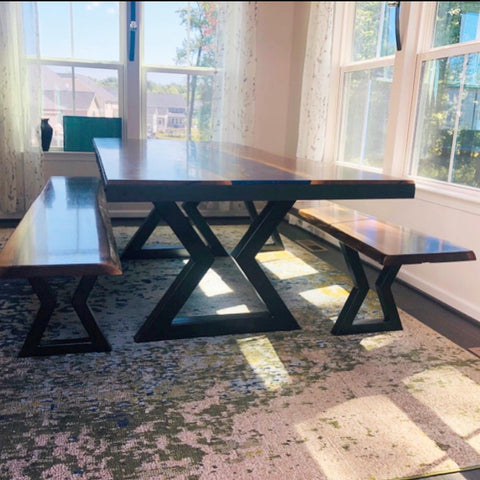Upgrade Your Furniture with Custom Dining Room Table Legs
Upgrade Your Furniture with Custom Dining Room Table Legs
Blog Article
From Typical to Modern: Discover the Suitable Eating Room Table Legs for Your Design
While timeless designs such as cabriole and turned legs stimulate a feeling of classic refinement, modern designs like hairpin and geometric choices provide a chance for striking visual interest. As you think about these components, the concern stays: just how can you effortlessly integrate these varied leg styles to create a harmonious dining experience?
Comprehending Table Leg Styles
The variety of dining-room table leg designs can significantly affect both the aesthetic appeals and functionality of the area. Each leg style adds special useful functions and aesthetic components, accommodating diverse layout choices and use requirements. Understanding these designs is vital for choosing the ideal table that aligns with your general interior decoration vision.
For circumstances, tapered legs offer a tidy, traditional look that can improve an area's elegance, while pedestal bases supply stability and make best use of legroom, making them perfect for smaller sized areas. Barrette legs, a hallmark of mid-century modern design, present a commercial flair, permitting a ventilated, open feeling. Trestle legs stimulate rustic appeal, offering robust support and a sense of eternity.
Wooden legs can bring warmth and appearance, whereas steel choices frequently convey a sleek, contemporary vibe. Inevitably, recognizing table leg styles is vital for developing a cohesive dining location that shows personal style while guaranteeing practicality and comfort.
Traditional Table Leg Options
When selecting dining-room table legs, traditional choices typically personify timeless elegance and craftsmanship. These layouts reflect an abundant heritage and a commitment to high quality, making them excellent for those that appreciate traditional aesthetic appeals.
One of the most iconic standard leg designs is the cabriole leg, characterized by its elegant bent form. This style typically includes decorative carvings and is most frequently found in Queen Anne and Chippendale furniture. One more prominent option is the transformed leg, which boasts a series of smooth, rounded forms that offer a classic appearance while keeping stability.
Moreover, the straight leg, while straightforward, offers a durable and unadorned structure that can blend perfectly with a variety of tabletop designs. For those drawn to ornate outlining, claw-and-ball feet legs evoke a feeling of majesty and can work as a spectacular focal point in any kind of eating area.
Finally, pedestal bases, although not purely legs, offer an alternative traditional option that enables enough legroom and can be wonderfully carved. Each of these conventional leg styles adds to the overall atmosphere of an eating area, marrying function with visual allure.

Modern Table Leg Layouts
Modern table leg layouts offer a diverse series of styles that stress clean lines and ingenious products. These designs frequently focus on performance while functioning as striking prime focus within an eating area. Minimalist looks are prevalent, with legs crafted from materials such as metal, glass, and crafted wood, which add to a contemporary and airy feel.
One popular layout is the barrette leg, characterized by its slim, tapered framework that provides security without overwhelming the table top (dining room table legs). This style is commonly found in mid-century modern-day furniture and can easily match numerous table forms. One more pattern is the usage of geometric forms, where legs might handle angular or asymmetrical forms, including visual interest and a touch of virtuosity

Blending Styles for Distinct Spaces
Typically, home owners seek to create distinct eating rooms that reflect their individual design by blending various design components. This technique permits the incorporation of varied aesthetics, resulting in a harmonious yet distinctive atmosphere. my blog Coupling a rustic wood table with streamlined, modern steel legs can develop an appealing contrast that elevates the space's overall charm.
In addition, integrating vintage table legs with modern tabletops can evoke a sense of background while maintaining a modern-day sensibility. Such combinations not only showcase specific taste yet additionally motivate imagination, allowing home owners to curate an area that really feels both personal and welcoming.
Shade plays an essential role in this blending procedure; picking table legs that match or contrast with the existing color design can improve visual passion. Whitewashed legs can soften the daring of a dark table surface, developing a balanced aesthetic.
Tips for Choosing the Right Legs
Choosing the right table legs is necessary for achieving both capability and visual appeal in your eating area. Begin by considering the general browse around this web-site style of your area. Standard settings take advantage of legs that feature intricate makings or transformed designs, while modern rooms may require sleek, minimalist styles.
Following, assess the elevation and security of the legs. dining room table legs. Conventional table a fantastic read range in between 28 to 30 inches in height, so make certain the legs enhance this dimension for comfort. In addition, robust products, such as hardwood or metal, can boost stability and durability
Review the leg form also-- alternatives consist of right, tapered, or pedestal designs. Straight legs provide a timeless look, while tapered legs can add a touch of elegance. Pedestal bases provide sufficient legroom and are ideal for smaller sized areas.
Verdict
In recap, choosing the optimal eating space table legs requires mindful factor to consider of both contemporary and traditional styles. By balancing leg design, height, and product with the overall decoration, a natural and inviting atmosphere can be accomplished.
The variety of dining room table leg styles can considerably influence both the aesthetic appeals and performance of the area. Ultimately, recognizing table leg styles is essential for developing a cohesive dining area that reflects personal design while making certain functionality and convenience.One of the most legendary conventional leg styles is the cabriole leg, identified by its graceful curved shape. Straight legs provide a classic look, while tapered legs can include a touch of sophistication.In recap, selecting the optimal dining area table legs needs mindful consideration of both modern-day and traditional styles.
Report this page